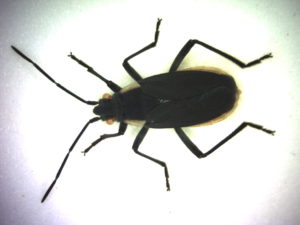In the spirit(s) of the season, I wanted to share a ghost story from the lab with you all…

Here in the bug lab, mysteries abound. Dr. Angelini, along with his students and associates, seeks to understand the genetic mechanisms for the extraordinary adaptations that our research bugs display. While many current experiments focus on wing development, one particular feature is as striking as it is mysterious.

One of the most obvious things about seeing a red-shouldered soapberry bug (Jadera haematoloma) juvenile in the wild is the bright red color of it’s body. Within each bug, certain parts of its DNA genes hold the instructions for making this powerfully visual palette. Most hatchlings will even emerge from their eggs already a splendid shade of red! But many populations of the bugs also carry different versions of the genes, called alleles, that carry the code for different colors or pigments. Sometimes, these other versions can be present in high enough numbers that recessive alleles combine and rare forms, or phenotypes, are seen. When this happens, a ghost appears!

Instead of the cardinal red of the typical soapberry bug, an eerily opaque white-gray is present. In our lab, this particular phenotype goes by the name ghost (gh for short). Some say the name comes from the color of the bug’s thorax, so close it is to the color of the lacy wisp of the traditional phantom. Others attest to the name recalling how the bugs tend to disappear during experiments (often likely to turn up in a shirt pocket or upturned cuff later in the evening, to everyone’s surprise).

While much time and effort has been devoted to unraveling the mysterious causes and reasons for the peculiar palette, more research is needed to bring the strange features of these creatures to light.




